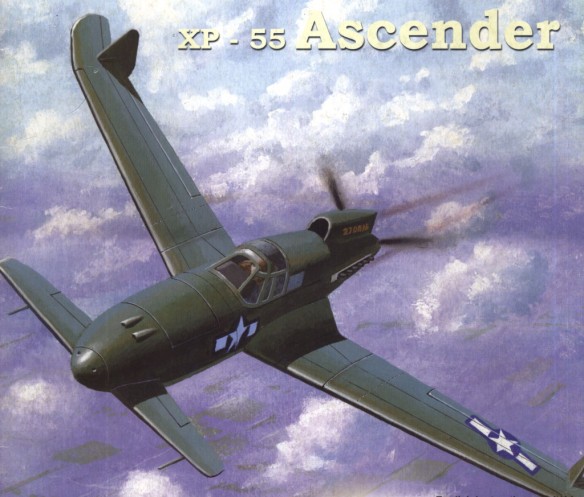
A rare colour image of the first XP-55 during an early test flight. On 15 November 1943, test pilot Harvey Gray was carrying out high level stall tests, when the aircraft suddenly entered an inverted spin from which he was unable to recover. He exited the aircraft safely before it crashed. A special feature of the XP-55 was a propeller jettison lever located inside the cockpit to prevent the pilot from hitting the propeller during bailout.
Experimental fighter of canard configuration with a pusher engine, designed in repsonse to the R-40C specification. The XP-55 had unimpressive performance. Three built.
Canard-equipped, swept-wing and rear-engined. Today this might be the configuration of choice for a jet fighter, but in the 1940s it was unheard of. But that did not stop the engineers from Curtiss-Wright producing the XP-55 Ascender, a futuristic-looking aircraft that sadly did not live up to the hype.
With the prospect of the US being drawn into World War 2 becoming ever more likely, in 1941 the US Army Air Corps sought to `jump-start’ fighter designers and spur them to depart from accepted, low-risk, aircraft design practices and embrace radical new technology. It sponsored three unorthodox fighter aircraft designs by Vultee (a twin-boom pusher called the XP-54), Northrop (a bobbed-tail lying wing called the XP-56 Black Bullet) and Curtiss-Wright (XP-55 Ascender). With shackles released, the Curtiss-Wright designers let their imaginations run riot and configured a short wing, or canard, near the nose, added two vertical tails to the swept wings and mounted an engine in the tail with pusher propeller.
Initially all three designs were to be powered by a unique liquid-cooled Pratt & Whitney 28-cylinder `H’ engine. However, development problems arose and the engine fell short of projected power ratings, forcing the US Army Air Corps to turn to less powerful but more conventional powerplants. Exhaustive windtunnel tests on the unorthodox Curtiss-Wright design produced disappointing results, but this did not prevent a contract being issued for three prototypes equipped with the new Allison V-1710 engine under the designation XP-55 Ascender.
The aircraft made its first test ‑ flight on 19 July 1943 from the Army’s Scott Field near the Curtiss-Wright plant in St Louis, Missouri, in the hands of company test pilot J. Harvey Gray. Initial testing revealed that the take-off run was excessively long. To solve this problem, the nose elevator size was increased and the aileron up trim was interconnected with the ‑ aps so that it operated when the ‑ flaps were lowered. The test schedule progressed satisfactorily until 15 November 1943. Harvey Gray was testing the aircraft’s stall performance at altitude when the XP-55 suddenly ‑ flipped over on its back and fell in an uncontrolled, inverted descent. The aircraft fell out of control for 16,000ft (4,900m) before Gray was able to parachute to safety. The aircraft was destroyed.
Ascender number 2 ‑ flew for the first time on 9 January 1944, with major restrictions on in-flight manoeuvring. The third prototype ‑ flew late in April. After much testing, it looked as though Curtiss engineers had cured the deadly stall situation that doomed the first XP-55. Curtiss retrofitted the stall fixes into prototype number 2 and resumed testing in September 1944. The US Army Air Forces (USAAF) carried out some armament testing with Ascender number 3 but the end was near for the whole project. Pilots feared the Ascender’s vicious stall characteristics, and it was slow compared to most fighters already in production. The programme ended after the third prototype crashed at Wright Field during an air show. Ultimately, the Ascender’s performance and handling were too poor for an effective combat fighter. Fast-forward to today, and the Curtiss-Wright engineers have the right to feel vindicated in their unorthodox design configuration. Many would argue that, as such, it really was an aircraft ahead of its time.
Type: XP-55
Type: Experimental fighter
Year: 1943
Crew: 1
Wingspan: 40ft 7in (12.37m)
Length: 29ft 7in (9.02m)
Height: 10ft 0in (3.05m)
Max Take-Off weight: 7,930lb (3,597kg)
Powerplant: 1 x Allison V-1710-95 of 1,275hp
Max Speed: 390mph (628km/h)
Armament: 4 x 0.50in (12.7mm) machine guns in nose
Ceiling: 34600 ft
Max. Range: 1440 miles